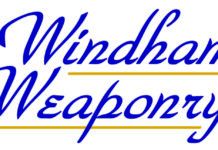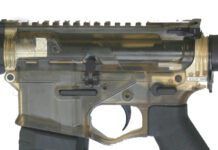It wasn’t too many years ago that hunters who wanted an accurate, but controllable, handgun for hunting small or medium-sized game had very little to choose from. That situation has changed for the better in the last 10 or so years, and consumers now have plenty of options from which to choose. In fact, as in the rifle market, they can even pick action styles in their handguns, choosing from break-actions like the Thompson/Center Contender and Encore models, bolt actions from Savage, Remington, and Weatherby, and cannon-breech guns like those made by Magnum Research.
Each manufacturer is looking for the best way to skin the cat, of course, and recent testing we conducted on three hunting handguns in this class suggest that no one has a corner on technology in this market. We shot hand rifles chambered for .22-250 Remington from Savage, the bolt-action 510F Striker, $425; Thompson/Center’s break-action Encore, $546; and the rotating-breech Lone Eagle from Magnum Research, $588. One major factor we sought to examine here was if any of the actions had a noticeable edge over the others in accuracy, primarily, but also in ease of use, follow-up shots, and other field considerations.
Range Session
Due to higher-than-normal winds we limited testing to a distance of 50 yards from a sandbag bench rest. Firing from a bench with sandbags was affected by the profile of the base of each grip. It isn’t an accident that we felt the most steady with the widest grip platform of the Savage and least secure with the smallest one found on the Lone Eagle. In an October 1998 test of the 510F Striker’s predecessor, the 510, we noted this same advantage. Savage was smart to keep the feature on the 510F.
The Lone Eagle came mounted with Leupold’s Vari-X 2.5X8 EER scope ($349 separately), which is one of a series of Leupolds found in the Magnum Research catalog. Due to a difference in mounting set ups, we weren’t able to share this scope with the other two guns. We substituted optics that were sufficient for testing at 50 yards, as the tight accuracy rankings show. Otherwise, here’s what we thought of the guns individually.
Thompson/Center Encore
Our recommendation: At $546, this gun is pricey, but we found it compact and easy to operate. The Encore is fun to shoot and holds well even while standing unsupported. This single-shot design is available in a variety of larger cartridges, including .50-caliber black powder, but for some shooters, the .22-250 Remington may be approaching the limits of comfort. The barrel release needed a little use to wear in, which we were happy to provide. The Encore proved addictive, and we soon dreaded any interruption of the shooting drill: Break open using the middle and ring finger to pull down on the trigger guard, insert a round, close, thumb the hammer back, aim and fire. Repeat as necessary. There is no arguing with simplicity.
While this gun did recoil the most, we would not classify it as unpleasant. For larger calibers, porting from the Thompson/Center custom shop is available. The Encore comes with a set of adjustable iron sights that, when removed, uncover tapping for a one-piece base and ring assembly. Thompson’s dual-ring mount sells for $61. The barrel hinges on a stout pin that is captured by the walnut fore end. The barrel and grip frame arrived in two different boxes and can be purchased separately, accenting the interchangeability of this design.
While the grip is pistol-like, we were more comfortable placing our weak hand on the forend than wrapping it around the strong hand, as with a traditional pistol hold. From the bench, we placed two hands on the grip, however, and took advantage of its flat bottom to the steady the gun.
The trigger face is gently rounded, with a sheer vertical drop. Cocked or at rest , the trigger position and relation to the hand is the same. There is no take up, just a very smooth, crisp release. The hammer is blocked from the firing pin and sits almost one-eighth inch away when at rest. The Encore was the only gun to take full advantage of the PMC ammunition, firing its best groups with this 55-grain round. Five-shot groups ranged in size from 0.8 inch to 1.0 inch. The Encore averaged 1.0 inch per five-shot group for all rounds fired.
Savage Model 510F Striker
Our recommendation: This gun’s higher capacity is a big plus for field shooting. As a pure hunting tool, it would be our first pick.
Savage seems more conscious of transferring the characteristics of a rifle to handgun design than its competitors. The Savage 510F is the only multiple-shot gun in this test. An enclosed magazine holds two rounds for a capacity of 2+1. But there are other differences worth noting as well.
[PDFCAP(2)].The Savage also features a floating barrel, which the others lack. If this makes the 510F more rifle-like, then the trigger makes it more pistol-like. The trigger is deeply arced and features a soft take-up that offers a feel that is just short enough, just crisp enough, not to be considered mushy. We liked the feedback the trigger provided, and while firing we were able to continue to drive the sights to the center of the target throughout the press. Our scope of choice here was the Aimpoint 5000XD, a 2X power electronic dot scope which we feel worked right into this technique.
The grip on the Savage ends with a wide, flat base that adapted well to benchrest shooting. Hornady’s moly-coated VX (Varmint Express) were its favorite round, averaging a group size of only 0.8 inch.
The synthetic stock is one piece, and the grip and the finger grooves are ambidextrous. Offhand shooting with two hands on the grip was difficult, in our view. We never felt totally comfortable reaching for the forend with our weak hand. (Each of these guns is a good candidate for accomplishing off-hand shooting using the special ladder-type scope mount that separates the gun and scope sufficiently to make the scope a solid place to grip.)
The bolt is mounted on the left side and is operated by the weak hand. As unwieldy as it might seem holding the gun in one hand and operating the bolt with another while not pressed against the shoulder, as it would when operating a full-size rifle, it is actually an easy and quick task to perform. The ready availability of three rounds in the gun instead of only one make this hand rifle a superior hunting weapon.
Magnum Research Lone Eagle
Our recommendation: The rotating breech on this gun is incredibly strong, and the Lone Eagle should satisfy anyone with a thirst for a good weapon with taste and flair.
Like the Thompson, the Lone Eagle is available in multiple calibers (18 in fact) that can be switched out on demand. The caliber switch is more costly on the Lone Eagle because, unlike the Thompson product where all that’s needed is a different barrel, wherever a Magnum Research barrel goes the action goes with it. Lone Eagle actions range in price from $319 to $469 dollars, depending on whether they are black, chrome, or include a muzzle brake.
Our test gun featured a chrome action with a muzzle brake, a top-of-the-line weapon. We chose this particular gun to give us some contrast on how the unbraked model (which we tested in the March 1998 issue) performed.
Cocking the gun is accomplished by pulling the lever on the left side of the synthetic receiver. Sculpting on the grip is ambidextrous, but a lefty would have to remove his strong hand to put the gun into battery. Otherwise the lay of the grip and balance of the gun is much like a full-size pistol. The safety is a cross bolt that a right-handed shooter can activate with the weak-hand thumb and turn off with the inside of the trigger finger without changing grip. The trigger is gently arched with a flat face devoid of serration, and to the finger feels nearly straight up and down. There is no take-up or overtravel in this trigger, but initially we detected creep that fooled us a number of times. Also, the rotating breech was stiff and wouldn’ t open far enough to pop out the empty shell. Happily, a break-in period of some 50 rounds was enough to banish the trigger creep and enable the breech to operate as it should.
For shooting .22-250 Remington, we feel that the muzzle brake was perhaps overkill. While we did not remove it to compare the lack of felt recoil, any lessened recoil benefits were offset by muzzle blast. The other guns got along fine without a brake, as did our March 1998 sample. This is no small issue, because adding a brake to any of these guns jumps their costs significantly. However, we don’t doubt the advantages of compensation when firing more potent chamberings. Besides choices of barrels and scopes, other options in the Magnum Research catalog include slings, lanyards, hip and shoulder holsters.
That the Lone Eagle was more slightly more accurate than the other two pistols may have been a result of superior function, a better scope to gun match up, or simply the fact that it was shot under better light and wind conditions. The Leupold scope was more powerful than the other two, but at 50 yards it also presented much more reticle movement. More than any other mechanical factor, our test staff wanted a flatter base at the grip of Lone Eagle to stabilize our hold upon the bench. Had the Lone Eagle sported the grip of the Savage, for example, we feel this would have made it possible to shoot even more accurately.
As it was, the Lone Eagle shot on average 0.2 inches per group tighter than its competitors. Still, each gun managed to find a load out of our narrow selection that produced a majority of groups measuring less than 1 inch at 50 yards.
Gun Tests Recommends
Thompson Center Encore, $546. Buy It. With the Encore, you are paying for reliability, simplicity, and versatility. It handles well off a bench, supine, or standing unsupported. In terms of a physical characteristic that sets it apart, we’d rate it best for shooters with smaller hands.
Savage 510F Striker, $425. A Best Buy. With this gun, you put in the least money and shoot the most rounds without reloading. If you like rifles better than handguns, you might like this one best. The grip works best from a bench or prone, and we feel it favors larger shooters as well. Featuring a floating barrel, we feel the Striker’s performance may have more upside potential with a little tinkering.
Magnum Research Lone Eagle, $588. Buy It. The Lone Eagle takes care of business with the most pizzazz. It handles like a pistol, but eats up rifle cartridges like no other. This has much potential for hunting and silhouette shooting.





























